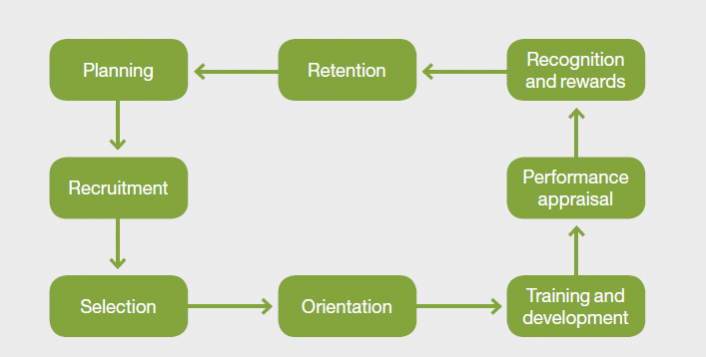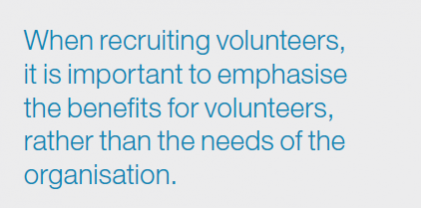PHASE 1: HUMAN RESOURCE PLANNING
This phase essentially is about assessing and forecasting the staff (paid and volunteer) needs of the organisation and is very important to ensure staffing levels are satisfactory with the program needs. In this phase program manager/coordinators must assess: whether current staffing needs will be adequate to meet future demand (or alternatively; whether fewer staff will be required); whether staff turnover is predictable and can be accommodated; whether the ratios of paid to volunteer staff are appropriate or adequate; whether there are annual or cyclical fluctuations in staffing that need to be met and managed, and; whether specific capabilities will be required in the future that the organisation is currently lacking. After the job analysis, job descriptions should be constructed for each role (paid staff and volunteers). A job description specifies the title, supervision (who the person supervises and by whom the person is supervised), duties, conditions (e.g. Days, hours, frequency) and specialised skills or qualification (e.g. coaching accreditation). A job description enables potential volunteers to understand what is expected of them before taking on a position. Areas to include in a job description are outlined below:
- Position title
- Responsible to
- Direct relationship with
- Purpose of role
- Key task and responsibilities
- Desirable personal qualities
- Experience and/or qualifications
- Timing (Approximately hours/days required)
An example of a job description can be found in the appendix of this resource manual.
PHASE 2: RECRUITEMENT
Recruitment is the process of attracting new volunteers to sport and active recreation organisations. An important question to ask is ‘Why do people want to volunteer for our organisation?’ The personal benefits of volunteering are outlined in Table 6. For voluntary positions the recruitment process is often informal and being able to attract a pool of qualified applicants can be a difficult task. Personal contact with potential volunteers, whether through friends, family or individuals already involved in your organisation are among the most frequently cited ways that volunteers first become involved in voluntary work. When recruiting volunteers, it is important to emphasise the benefits for volunteers, rather than the needs of the organisation. Many volunteers give up their leisure time to help sport and active recreation organisations and may not be attracted by work-like recruitment campaigns. Volunteers need to feel valued by the organisations and not feel as though they are being recruited to fill a position that no one else wanted.
Other examples of recruitment:
- Newspaper ads or story’s
- Organisation websites
- Information sessions at conference/seminars
- Community Radio
- Television
- Direct mail
- Displays/Booths
- Piggybank Events e.g. Sport days, annual meetings
- Postcards to current volunteers to hand out to friends/family/others
PHASE 3: SELECTION
- The selection process involves choosing the individual who best meets the requirements of a position. Depending upon the level of the position (policy/management or operational) the selection process can involve a number of steps which may include screening, formal interviews, testing, reference checks and additional checks such as working with children card and police checks. Industrial relations legislation covers a range of organisational and employment issues and these also relate to volunteers. It is important to comply with these laws and regulations throughout the HRM process so that your organisation is not exposed to claims of discrimination or bias (on the basis of race, colour, country of birth, ethnicity, disability, religion, sex, age, marital status, pregnancy or sexual preference).
Example questions NOT to ask in an interview may include:
- How old are you?
- Do you have a problem working with younger people?
- Are you married?
- Do you have any children?
- Where do you attend church?
- What are your views on taking prohibited drugs?
- Please send a recent photo with your application form.
- What are you going to do about your weight problem?
The following website will provide additional information in this area:
http://www.humanrightscommission.vic.gov.au/index.php/the-workplace
PHASE 4: ORIENTATION
Orientation is the final step in the recruitment process. New members are welcomed to the organisation and given details about their position, the day to day operation of the organisation, and introduced to key people. Taking up a new position is a critical period for new volunteers and for the organisation. Volunteers are making a transition from being an outsider to an insider within the organisation. New recruits cannot be expected to understand the requirements of their new position or how the organisation functions on a day-to-day basis. For example, a new Group Leader needs to know where the equipment is stored, how to access it, what to do in case of an emergency and so on. A well designed orientation process reduces stress on new volunteers, makes them feel welcome and may reduce the likelihood of turnover.
Orientation is based on the process of socialisation, which is about influencing the expectations, behaviour and attitudes of a new volunteer in a manner considered desirable by the organisation. Some organisations run formal orientation programs which prelude a more detailed training and development program. In many sport and recreation organisations, the orientation process is less formal, but not less important if volunteers are going to perform their new roles successfully.
Orientation Program Checklist Example:
- Provide an orientation guidebook or kit.
- Provide copies of current newsletter and annual report.
- Provide a copy of policy and procedure manual.
- Enter the name, address and contact details of each volunteer into the database.
- Gather and file copies of qualifications and accreditation certificates form each volunteer.
- Fill in appropriate paperwork and forms such as Working with Children Check and Police (crimcheck) checks.
- Introduce the organisation’s culture, history, aims, funding, participants/members and decision-making processes.
- Introduce key volunteers and/or staff (and organisational chart).
- Outline the roles and responsibilities of key volunteers and staff.
- Detail the roles and responsibilities and accountabilities of the volunteer in their new role.
- Familiarise volunteers with facilities, equipment and resources.
- Explain and ‘walk through’ emergency and evacuation procedures.
- Familiarise volunteers with the organisations day to day operations (telephone, photocopier, keys, filing system, tea/coffee making, organisation processes and procedures).
(Source: Australian Sports Commission website at: www.ausport.gov.au)
PHASE 5: TRAINING AND DEVELOPMENT
The level of competency of volunteers can have a significant impact on the success of sport and active recreation organisations. Training is about teaching specific job skills whereas development prepares volunteers for future roles or responsibilities and satisfies individual’s needs for personal growth. Training and development should not only be offered to new recruits. Individuals who have been with your organisation for some time, but who are taking on a new role or planning to do so, will also need access to appropriate training and development opportunities. Training and development opportunities will vary widely from organisation to organisation and need to be adapted to suit the needs of individual volunteers as well as the organisation’s needs and level of resources.
Examples of training may include:
- Teamwork Training
- First Aid Training
- Programming specific skills training i.e. Canoeing, high ropes course
- Group facilitation
- Sport Coaching
- Food preparation and safety training
- Specific policy’s and procedures of your organisation
- Inclusive Strategy’s
PHASE 6: PERFORMANCE APPRAISAL
Good sport and active recreation organisations seek ways of maximising the performance and satisfaction levels of their volunteers. Performance appraisal is the process of evaluating the effectiveness of volunteers and providing them with feedback. Performance appraisals should recognise and reward volunteers who have done a good job and identify where improvements in volunteers’ job performance can be made. Generally a performance appraisal is informal and a way of communication rather than a formal process. Mentoring can also be a way of allowing more experienced and skilled volunteers to share their knowledge with recently recruited or less experienced peers. It enables experienced volunteers to help improve performance through informal appraisals that occur as a result of a mentoring process.
Things you may discuss with a volunteer as part of the performance appraisal process:
- Volunteer Expectations of the organisation towards their role.
- Specifics of the tasks the volunteer is involved with.
- Interpersonal skills with participants, other volunteers and staff.
- Training or development requirements.
PHASE 7: RECOGNITION AND REWARDS
Recognition is very important for valuing volunteers and their efforts within sport and active recreation organisations. All volunteers who volunteer for your organisation deserve some form of recognition even if it is a simple thank-you for helping out. Recognition and reward programs tend to work best when they are individualised, varied and open to new and interesting ideas. Forms of recognition and reward do not need to be complicated and expensive to establish and administer, but they are an essential component of effectively retaining the services of your volunteers.
Examples of ways to give recognition to your volunteers:
- Smile and say hello/thank you etc.
- Send a birthday card
- Arrange for discounts i.e. Gym memberships with your organisation
- Plan annual ceremonial occasions
- Recognise personal needs and problems
- Provide good orientation and training
- Award certificates or plaques for years of service
- Take time to talk and discuss with your volunteer(s)
- Carefully match volunteer with a role
- Celebrate outstanding projects or achievements
- Plan staff and volunteer social events
- Encourage volunteer participation in team planning
- Enable volunteers to ‘grow’ on the job
- Keep volunteers informed via newsletter
- Provide letters of reference
- Honour volunteers on International Volunteers Day, December 5th
- Celebrate National Volunteer Week in May
PHASE 8: RETENTION
Well done, you have successfully encouraged people to volunteer for your organisation. That’s the easy part. Now you have to retain them!
The goal of retention is to develop a sense of organisational commitment among volunteers. Although volunteer turnover is to be expected in sport and active recreation organisations and creates opportunities for organisational change, high rates of turnover can hinder the quality of care and range of services to your participants. Organisations with high turnover rates of volunteers may have to divert large proportions of limited resources to recruiting, orientating and training new volunteers. This is why it is essential to ensure volunteers, are managed using appropriate and supportive HRM processes to ensure volunteers are retained with your organisation.



